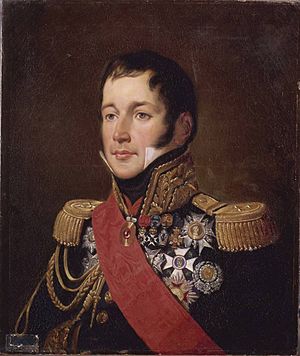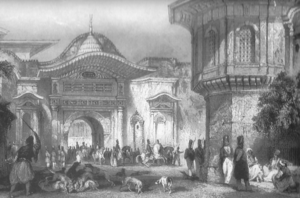Armand Charles Guilleminot facts for kids
Quick facts for kids
Major-general
Armand Charles Guilleminot
|
|
|---|---|

Portrait of Armand Charles Guilleminot by Louise Adélaïde Desnos, 1843
|
|
| Born | 2 March 1774 Dunkirk, France |
| Died | 14 March 1840 (aged 66) Baden, Germany |
| Buried |
Père Lachaise Cemetery
|
| Allegiance | Napoleon Bonaparte Kingdom of France |
| Years of service | 1789—1840 |
| Rank | Major-general |
| Battles/wars | Brabant Revolution Battle of Verona Battle of Medina de Rioseco Battle of Borodino Hundred Days Battle of Waterloo |
| Signature |  |
Armand Charles Guilleminot (born March 2, 1774 – died March 14, 1840) was a very important French general. He served during the Napoleonic Wars, a series of major conflicts in Europe. People described him as smart, kind, generous, and full of good ideas. He earned the highest award in France, the grand-croix title of the Legion of Honour.
Contents
Life Story of General Guilleminot
Armand Charles Guilleminot was born in Dunkirk, France, on March 2, 1774. His parents were Claude Guilleminot and Isabel-Barbe Lanscotte. He had seven brothers and sisters.
Joining the Army
At just 15 years old, in July 1789, Guilleminot joined the army. He volunteered for the National Guard of Dunkirk. His first battles were against the Austrian forces, including in the Brabant Revolution.
In 1792, he became a junior officer, called a sous-lieutenant. He then served in the Army of the North. He worked closely with General Souham as his special assistant, called an aide-de-camp. This was during battles like the Battle of Tourcoing.
After a general named Dumouriez changed sides in 1793, Guilleminot was held for a short time in Lille because some people suspected him of disloyalty. After this, he joined the Army of Sambre and Meuse. He quickly rose through the ranks, becoming a lieutenant in 1796 and a captain in 1797. He later moved to the Army of Mainz.
Early Battles and Promotions
Guilleminot fought in the Battle of Verona in 1799. After this, he was promoted to battalion commander. General Moreau noticed his skills and asked him to join the Army of Italy as his aide-de-camp. He also served with the Army of the Rhine. Because he was close to Generals Moreau and Pichegru, he was again viewed with suspicion for a short time in the early 1800s.
Mapmaking and Diplomacy
In 1802, Guilleminot started working in cartography, which is the art of making maps. He was attached to the German Army. By 1805, he moved to military mapmaking and history services. He was sent to Dresden, Germany, to work as an engineer and mapmaker for the military.
Later, he rejoined the Grande Armée (Napoleon's main army) under Marshal Berthier. This was during the War of the Fourth Coalition. After this war, he traveled to Turkey. His mission was to tell the Ottoman Empire about the peace agreements between France and Russia, known as the Treaties of Tilsit.
Fighting in Spain and Russia
In 1808, Guilleminot was the first Frenchman sent to Bayonne, Spain, for the Peninsular War. He became the chief of staff (a top assistant) to Marshal Bessières. He was in Madrid during the Dos de Mayo Uprising, where he helped control the situation. He also fought in the Battle of Medina de Rioseco. After this battle, he was promoted to brigadier general. Soon after, he was given the title of Baron of the Empire. He then became chief of staff for Soult's army corps. In 1810, he was chief of staff for the Army of Catalonia.
In 1812, he became chief of staff for Prince Eugène's army corps. He was hurt in the Battle of Borodino. However, just a month later, he led the 84th Infantry Regiment at the Battle of Maloyaroslavets. This was after their general, Delzons, died in battle. He led this regiment through several more battles before the armies had to retreat in early 1813.
Later in 1813, he took part in the Russia campaign. He became a major-general after showing kindness at the Combat of Roßlau. He then took command of an army corps from Marshal Oudinot. He led them into battles like Großbeeren and Dennewitz. He also commanded the 13th Division and fought in battles like Hanau and Mainz.
After Napoleon
Napoleon Bonaparte gave up his power in 1814 and was sent away to the island of Elba. Guilleminot was made chief of staff to the Duke of Berry during this time. When Napoleon escaped and returned to power in 1815, Guilleminot became chief of general staff for the Imperial Army in the Army of the North.
Just before the Battle of Waterloo, Guilleminot served as second-in-command of Jérôme Bonaparte's division during the Hundred Days period. After the French lost at Waterloo, Guilleminot was sent to talk about the surrender of Paris to the Prussian leader Marshal von Blücher. He was held as a prisoner for a short time until the Convention of Saint-Cloud was signed. He was one of the people who signed this important agreement.
Later Career and Diplomacy
After his active military career, Guilleminot took on more administrative roles. He was very interested in different studies. In 1816 and 1817, he helped set the land borders between France and Switzerland. In 1818, he joined the kingdom's defense commission.
In 1821, he became a high-ranking official in the Council of State. In 1822, he directed the war depot and helped reorganize it. In 1823, during France's campaign in Spain, he became the head-of-state for the Duke of Angoulême and managed military plans. He was also made the major-general of the Army of the Pyrenees.
Later that year, King Louis XVIII put him in charge of the French Embassy in Constantinople (modern-day Istanbul). He served as an ambassador there for almost 10 years. While in Constantinople, he worked with Sultan Mahmut II on reforms for the Ottoman military.
In 1831, he returned to France. He became the chairman of the border commission for France's eastern borders after the July Revolution. He also joined a new defense commission in 1836.
Family Life
In 1798, Guilleminot married Aimée de Fernig. She was the sister of General de Fernig. They had four children: Charles, Eugène, Henriette Aimée, and Augustine Hortense. Henriette-Aimée married Édouard-Léon, Count Roger of the North. Augustine-Hortense married a French diplomat named Jules-Émile Humann.
When Aimée died in 1837, he married Henriette-Aimée "Marie" Ebray the following year.
Death
Guilleminot was sick for a long time. He went to Baden, Germany, hoping the change of air would help him feel better. Sadly, he died there on March 14, 1840, at age 66. He passed away from a chest inflammation. He is buried in the Père Lachaise Cemetery in Paris.
Awards and Honours
Armand Charles Guilleminot received many awards for his service:
- After the Battle of Medina in 1808, he received the officer's cross for the Legion of Honour.
- In 1810, he was recognized as a Commander of the Iron Crown and a knight of the Military Order of Max Joseph.
- In 1814, the king made him a grand officer of the Legion of Honour and a knight of the Order of Saint Louis.
- In 1823, he was made a Peer of France for his services.
- Also in 1823, he became a grand cordon in the Legion of Honour and a commander in the Order of Saint Louis.
- In 1838, he received the Legion of Honour for the fourth time, this time as a grand-officer.
- He was also made a saltier in the Order of the Crescent.
There is a statue of Guilleminot on the outside of Dunkirk's town hall, honoring his memory.
See Also
 In Spanish: Armand Charles Guilleminot para niños
In Spanish: Armand Charles Guilleminot para niños



